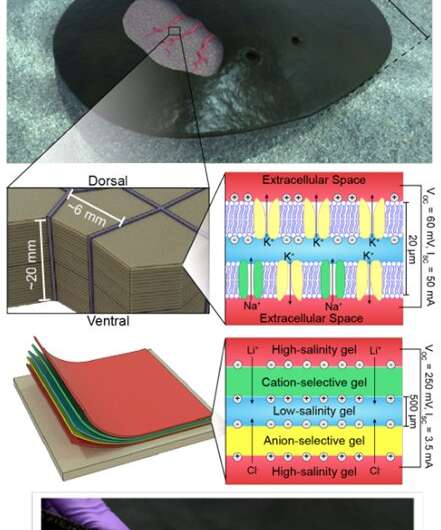Bio-inspired electricity sources could power wearable or implantable electronics in the future, even running on metabolic waste according to new research from the Adolphe Merkle Institute’s BioPhysics group at the University of Fribourg.
The group, led Prof. Michael Mayer, has focused on batteries that use differences in salt concentrations, known as an ion gradient, to produce electrical current while also seeking sustainable methods to generate such differences. One inspiration has been strongly electric fish, which use gradients of ions within their bodies to generate stunning external electrical discharges. Mayer’s team had previously developed an artificial electric organ inspired by the electric eel that generated electricity from ion gradients within stacked hydrogels, exceeding 100 volts. However, the current of this power source was too low to power standard electronics. For their next steps, the researchers chose the Atlantic torpedo ray’s unique morphology as the inspiration. This ray is the most powerful electric fish known and can produce pulses of over 1 kW.
They developed a hybrid material of hydrogel-infused paper to create, organize, and reconfigure stacks of thin, arbitrarily large gel films with differences in salt concentration in series and in parallel. Their results, published in the journal Advanced Materials, showed that the electrical power harvested was more than 60 times higher when compared with the original eel-inspired design, making it possible to run electronic devices. It also demonstrated that the biological mechanism of generating significant electrical power is possible with benign and soft materials in a portable size.
In another study, the AMI BioPhysics group has investigated the development of a sustainable process that could be used to recharge a bio-inspired battery, using carbon dioxide exhaled by a person breathing as an example. As revealed in the journal Advanced Science, the ability to generate an ion gradient from breath shows that there are achievable ways for a user to passively supply fuel for a power source. As a proof of concept, the researchers developed a prototype device that harvests enough energy from a breath-generated ion gradient to power small electronic devices, such as a light-emitting diode.
“This work is about using a metabolic waste product in conjunction with ion-gradient-based power generation to develop a wearable or implantable power source that could potentially be recharged indefinitely,” explains Mayer. “This is one more step towards having a battery that never needs to be plugged in, recharging passively, relying on ion transport rather than on chemical reactions to make it happen.”
The ongoing integration of technology into living organisms requires some form of power source that is biocompatible, flexible, and able to draw energy from inside a biological system. A self-charging power source for implantable devices such as heart pacemakers, sensors, drug delivery pumps, or prosthetics is an obvious application. Generating electricity inside the body would also eliminate the need for replacement surgery, and may also provide sustained power for wearable devices such as electrically active contact lenses with an integrated display.
Electric eel-inspired device reaches 110 volts
More information:
Anirvan Guha et al, Powering Electronic Devices from Salt Gradients in AA‐Battery‐Sized Stacks of Hydrogel‐Infused Paper, Advanced Materials (2021). DOI: 10.1002/adma.202101757
Trevor J. Kalkus et al, The Green Lean Amine Machine: Harvesting Electric Power While Capturing Carbon Dioxide from Breath, Advanced Science (2021). DOI: 10.1002/advs.202100995
Provided by
University of Fribourg
Citation:
Sustainable, implantable electronics move one step closer (2021, June 25)
retrieved 26 June 2021
from https://techxplore.com/news/2021-06-sustainable-implantable-electronics-closer.html
This document is subject to copyright. Apart from any fair dealing for the purpose of private study or research, no
part may be reproduced without the written permission. The content is provided for information purposes only.



